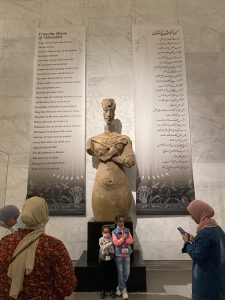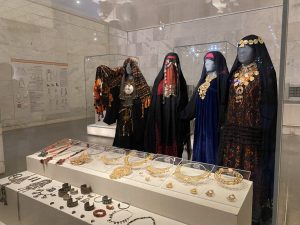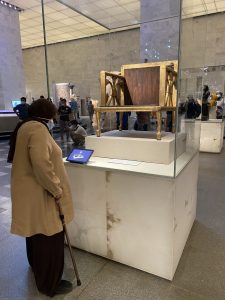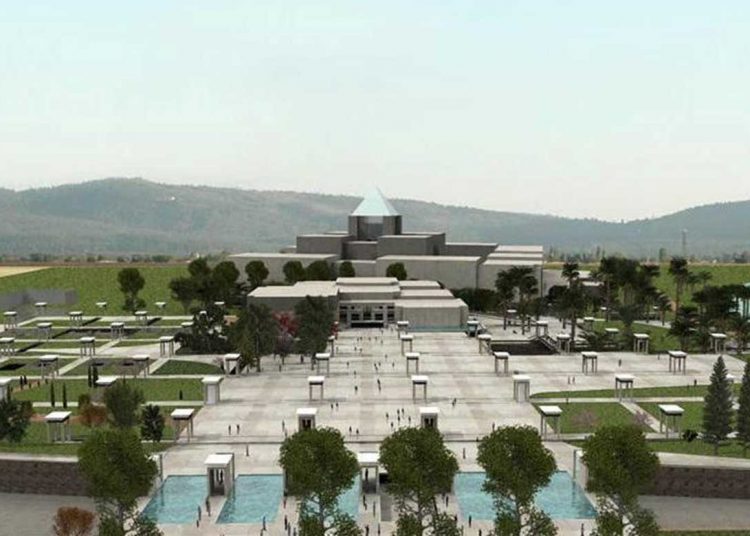President Abdel-Fattah el Sisi inaugurated and toured the National Museum of Egyptian Civilisation (NMEC) in Old Cairo’s Fustat last week — a few hours before the majestic parade of transferring the twenty-two royal mummies from Egyptian Museum in Tahrir Square to the NMEC.
The two-hour event was watched by millions of people worldwide. The mummies hall will be open to the public from April 18 as many people flock to the museum to see the artifacts on display in the main hall of the museum.
What attract the visitors once they enter the main hall of the museum is not just the precious and different artefacts but also the unique way of displaying them.
Mahmoud Mabrouk, ministerial advisor for the museum display, told Egyptian Mail, “The display in this 2000-square-metre hall is different from any other museum in Egypt.”
“One can see the artefacts of different ages together in one place, in one hall without any division between periods because the civilisations are mixed together,” Mabrouk said.
“Each period reflects the life of its people, not from a political perspective or on the rulers because these civilisations flourished on the same land.”
He added that they see the effect of Graeco-Roman period on the Byzantine age, the beginning of Islamic period is affected by the Coptic, the mosques of the early period of Islam are influenced by church architecture. Each period is interlocked with the period which preceding it.
The lighting of the hall and its broad space make the visitor feel comfortable, rather than being in the usual claustrophobic rooms in conventional museums.
“This main hall contains 1,600 artefacts. The tour starts counterclockwise, covering seven periods in the Egyptian history — prehistory, the dynastic period, Graeco-Roman, Coptic art, Islamic period, contemporary era and the traditional arts,” Mabrouk said.
Every civilisation and topic has a huge sign that gives full details in Arabic and English.

A stunning laid-out skeleton of a young man dates back to the Upper Paleolithic age, 35,000 years. He was buried near the village of Nazlet Khater in Sohag governorate. The spine of this tall man bears traces of carrying heavy loads, while a stone tool was placed next to him.
The prehistoric period went back to 2,300,000 BC which witnessed the evolution of humankind and its experiences since man lived in caves and rock shelters.
On display is a grinding stone that dates back to 5000 BC with which the ancient Egyptians prepared flour for making bread.

Silos were placed in homes for storing grain, which was fed in from the top and taken from the bottom as required. On display is one of the oldest examples of them.
A unique door of Kaemheset, dating back to the 5th dynasty of the Old Kingdom, is considered one of the oldest wooden doors so far on which the names of the royal architect Kaemheset and his son, royal architect Hetep Ka, who dedicated this door to his father’s tomb, are engraved.

Wooden coffin of Sennedjem, which contains his mummy, is decorated with funerary scenes of the protective gods from the Book of the Dead, while Sennedjem receives provisions from the tree goddess. Sennedjem worked on decorating royal tombs in the New Kingdom 19th dynasty.

A statue for ancient Egyptian pharaoh Akhenaten (ruled 1353–1336 BC) who abandoned Egypt’s traditional polytheistic religion and introduced monotheism, is attracting visitors to snap photos near his written hymn, which reads:
“When you rise upon the horizon
The day breaks
And you shine as Aten in the daytime
You dispel darkness
And when you give forth your rays
The two lands are in festival”
Ancient Egyptian musicians used such instruments as shepherd’s pipe, double pipe, clarinet, flute, mizmar, trumpet, round tambourine, sistrum, rattles, the brass cymbals, and wooden clappers, short and long harp and flutes. These instruments developed over time and became part of the orchestra in our time.

On display a limestone ostracon shows a sketch of a musical concert, which the artist was going to depict on the wall. The sketch gives us a complete picture for the composition of the ceremony. Depicting concerts and musicians was a common scene in the art of the New Kingdom.
A stunning limestone plaque of the Ptolemaic era depicts the goddess Nut giving birth to the goddess Isis on the birth chair, while the goddesses of birth with the head of the cow supervises the delivery.

Stoles worn by deacons include a wonderful example is on display with representations of some saints and Arabic writings as well. This one dates back to the 18th century.
Mashrabia, or oriel windows are among the most important artistic and architectural elements in the Islamic period, one of them decorates the museum. Mashrabiyas appeared around the 13th century AD and were most popular during the Mamluk and Ottoman periods.

Egypt’s cultural heritage contributed to human art and architecture in all its forms. If you are interested in traditional dress, did you know that in Sinai, an unmarried woman, a married woman and a widow wore distinctive attire? You will also see examples of costumes from Fayoum and Nubia, not to mention Bedouin garb and footwear.

Commenting on the great attendance by people to the Museum, Mabrouk said, “I am pleased that the guests are not just young people or antiquities enthusiasts, but I see a peasant, an old woman, children and youths looking at the exhibits with a great sense of pride.”
The museum is open daily during Ramadan from 9am to 3pm. Tickets cost LE200 for foreigners, LE100 for foreign students, LE60 for Egyptians and LE30 for Egyptian students. If you go before April 18, you will enjoy a 50 per cent discount on the ticket.






Discussion about this post